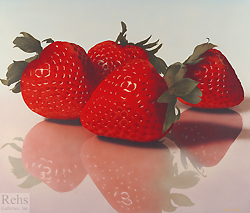John Kuhn
(Born 1948)
Five Iris
Acrylic on canvas
48 x 48 inches
Signed
BIOGRAPHY - John Kuhn (Born 1948)

Growing up in Hutchinson, Kansas in the 1950s, John Kuhn enjoyed what he describes as an idyllic childhood full of bike riding, neighborhood baseball and plenty of time to draw. His family encouraged his drawing as well as his fascination with assembling model cars and designing architectural models and small sculptures. Kuhn's mother, in fact, was an artist in her own right, not only doing occasional watercolors, but also designing illustrations for her four children's furniture and costumes for holidays and special events. The family home was filled with classical music as well, establishing a foundation not only for Kuhn's appreciation of music, but also a knowledge of music history that would later supplement his study of art history.
Kuhn received a basic art education in his public school, and took advantage of a unique summer art program in which the public school made the art classrooms available to anyone who was interested in using them. After graduating from Hutchinson High School in 1966, Kuhn enrolled for a year in Wichita State University before transferring to the University of Kansas at Lawrence. There, he majored in art history within the School of the Arts where he could also take studio arts classes. Although Kuhn recalls enjoying his art history classes, the social unrest of the late 1960s was a significant distraction to his studies. Like all young men during that era, the possibility of being drafted and sent to war in South Vietnam, was a constant concern. In 1971, when the Selective Service System implemented the lottery system, Kuhn was no longer in danger of being drafted, and decided to leave the university.
He worked briefly as a surveyor of building sites and for a local contractor, but was delighted to move into a job as a graphic artist for Centron Films in late 1971. As a producer of educational and industrial films, Centron needed graphic designers to produce advertising, brochures and some illustrations for the films. Not only was he introduced to the business of art, but he also learned a key skill for his future painting--how to use an airbrush. As Kuhn notes, "it was a hands-on job and a great education. Without that job, I wouldn’t be doing the paintings I’m doing now."
During his years at Centron, Kuhn also explored regional juried art shows, galleries and the local art scene in Lawrence, Kansas. In 1976, he also married a fellow artist, Margie, who today teaches as an adjunct professor at the University of Kansas. They share a studio, ideas and, Kuhn admits, most of the toys in his still life paintings come from her prop supply. When Centron was sold to a larger corporation in 1984, Kuhn felt he was ready to work full-time as artist. Although he acknowledges that it meant "muddling along with little money for years” he made gradual progress in finding venues for his work, including the Elaine Horwitch Gallery in Chicago.
The next decade was crucial for Kuhn as he began to refine his subject matter and his technique simultaneously. Increasingly, he relied on the airbrush to create photorealist imagery, and like some of the Pop artists that he admired, he had no hesitation about utilizing a commercial art technique for a fine art application. When digital photography appeared, he incorporated that into his process as well, using the digital images to help compose his painting, and then transferring an enlarged gridded image onto canvas. The use of gridded transfers has its roots in the fresco painting of the Italian renaissance, but the use of photography as a compositional tool dates from mid-nineteenth century France, just after the invention of the modern camera.
In terms of subject matter, Kuhn was typically painting nighttime images of theatre marquees, a theme that he shared with a number of other photorealists. That all changed one day as he watched Margie making tea. The striking shadows on the teapot and cups and caught his attention and he took a photograph immediately. When it evolved into a painting, Kuhn realized that still life painting might offer opportunities for new interpretations of textures and paint surfaces. Today, he has established parameters limiting his still life images to fruit, candy, toys and most recently, flowers. The subject is traditional, but Kuhn's marriage of formal precision with the soft edges created by the airbrush encourages viewers to look at these everyday objects from a fresh perspective.
Kuhn’s recent flower paintings also demonstrate the power of depicting everyday objects at a large scale. As he expands the size of his canvases, with some of them as large as 4’ x 4’, he also has more scope for exploring the surface of paintings. Standing in front of such an image, the viewer is immersed in the world on the canvas, experiencing the color, form and light of the painting both directly and immediately. Like his nineteenth century Realist predecessors, Kuhn offers an opportunity to objectively observe the visual forms of daily life, while inviting personal consideration of what those observations might mean beyond their overt functions.
Janet Whitmore, Ph.D.
| AVAILABLE WORKS | |||



